A Journey Through Wadi Daw’an, Yemen
Updated May 2023, A Journey Through Wadi Daw’an, Yemen was originally published in May 2020
Traveling through Central Yemen’s Wadi Daw’an was a definite highlight of our adventure that took us through the Governorates of Al Mahrah and Hadhramaut. The trip started by crossing the Oman-Yemen border near Surfeet, continuing on to the dusty seaside town of Al Ghaydeh.
From the coast, we continued north to camp under the stars with Mahri Bedouins in Yemen’s Empty Quarter and eventually headed west and descended into the Hadhramaut to visit Tarim and Shibam. Next, we made way toward the ethereal Wadi Daw’an.
Wadi Hadrhramaut is Yemen’s largest governorate, named after the broad wide valley that bisects a large swath of Yemen’s barren desert. But Wadi Hadhramaut is like an artery, branching and truncating in every-which-way, carved by rivers from long ago deep down into an arid plateau. One of these offshoots is Wadi Daw’an, which is arguably the most spectacular wadi that helps to comprise the larger Hadhramaut.
From Tarim that morning we headed west, making a quick stop across from the UNESCO World Heritage site of Shibam to see the city from outside its walls before continuing past small mudbrick home villages to a camp near the beginning of the valley.
Want to read more about traveling in Yemen? Check out my Yemen Travel Guide
Wadi Daw’an

The reason for stopping was to stock up on Qat leaf before continuing on to our destination for the next couple of days in Wadi Daw’an. There was a boy, that looked to be in his early teens sitting in the back of a busted out truck along the road, sitting cross-leged, selling the mildly narcotic leaves. He smiled as they bantered back and forth, his teeth stained a faint green from the qat in his cheek.


I’ve talked about qat leaf in other articles I’ve written about Yemen, but if you don’t know what it is, I’ll explain. Qat is a plant that is native to the Arabian Peninsula and the Horn of Africa, containing a stimulant that causes a mild euphoric high. The stimulant is called cathinone, an alkaloid whose side-effects include a loss of appetite, excitement, and insomnia.
All throughout Yemen, men typically start chewing qat leaf in the late afternoon and continue chewing it through the evening. I’ve seen bleary-eyed men wandering around in Sana’a, Tarim, Socotra, and Dar al Hajar with a cheek stuffed so full of qat it looked like they had a baseball in their mouth.
The use of qat leaf dates back hundreds of years in Yemen, as well as Somalia, Ethiopia, and Djibouti where the sale, consumption, and production of the leaves is perfectly legal.

Nearby was a sprawling camp alongside the road of makeshift tents, a few young girls came out to beg for rial as they had seen the car stop. The girls were originally from the Red Sea coast of Yemen near Hodeidah, their families, having fled the north of Yemen to the Hadhramaut at the outbreak of the Yemeni Civil War in 2015.
Many people from the north of Yemen fled to the Hadhramaut in waves, some of which live in pretty dire conditions as they cannot find work in Central Yemen, and being cut off from their homes due to ongoing Saudi and Houthi fighting and blockades.
Read what it was like to camp under the stars in the Yemeni Empty Quarter
Al Hajarayn
One of the first stops along the journey into Wadi Daw’an and one of the most striking is the village of Al Hajarayn. Al Hajarayn requires several stops to see it in all of its glory, from several different perspectives. The village seemingly dangles off the edge of a cliff, raised above the valley floor below with a wave of rock that rises above it and looms just overhead like the tail of a scorpion.

We all jumped out of the car and ran across the street to get a better glimpse of Al Hajarayn from a mound of rock and sand. Below we noticed a man making bricks and walked down to go talk to him.

His name was Mohammed. He was making the mudbricks the Hadhrami homes and palaces are traditionally made of. He explained his processes as sweat poured down his forehead and face while he slung a wheel-barrow full of mud down onto a wooden frame and then began smoothing the mud down into the frames.
Mohammed originally hailed from the Hadhramaut but went to Sana’a to work in a souq for several years before being forced to return to his homeland to escape the war. Not many opportunities were available in the region upon his return, so he began making bricks. Brick making earns a decent living for the area at about 9,000 Yemeni Rials per day.


After we said our goodbyes to Mohammed, we continued south, making another stop to photograph Al Hajarayn from an even more impressive angle as the golden sun began to drop.

Al Hajarayn is also renowned for its fine Sidr honey, but we forwent the stop as we would later go honey shopping on the way back out of Wadi Daw’an in a couple of days. The same can be said about the next location in the valley- Sif.
As the sun was beginning to set, we decided to make way to our final destination for the night at the far end of Wadi Daw’an. We passed village after village that seemed piled high with mudbrick homes and the occasional colorful palace, some that seemed perched impossibly on cliff’s edge.
As the sky began to tinge to pink and orange we climbed up high to the top of the northeast boundary of Wadi Daw’an, eventually popping up over the edge to the view of a flat, barren expanse as far as you could see.
The fascinating thing about seeing the Wad Hadhramaut region from both the ground level and from an airplane above is that you really get a better idea of the lay of the land. Nobody really lives atop the barren flat plateau, all the life and bustle happens deep in the valleys teeming with lush green vegetation, livestock, and people.

After a short period of driving along the plateau, we eventually reached a gate where we were briefly checked before driving on to our final destination- a palace built on the edge of Wadi Daw’an. Upon arrival, we all wandered the grounds checking out the epic views of Wadi Daw’an below until we got the call that it was time for dinner.
As we sat down, we heard that two American tourists would be arriving in the evening. We’d later find out that that they had gone from the Yemen-Oman border to Al Mukalla and then arrived at Wadi Daw’an from there. However, their journey was not that simple, as they had booked their trip through Easy Yemen, who is notorious for arranging fake paperwork, and pervy drivers and guides. They had spent over 5 hours earlier that day at a checkpoint thanks for forged paperwork.
Haid al Jazil
Sitting near the end of Wadi Daw’an Layasar, Haid al Jazil is the crown jewel of Wadi Daw’an, without a doubt. It’s the most beautiful place you’ve probably never heard of. Reminiscent of a more barren Amedi in Iraqi Kurdistan, and Bagnoregio in Italy, a boulder seemingly rises from the bottom of Wadi Daw’an about 100 meters high, with the pint-sized village of Haid al Jazil sat atop.
Many of the homes atop Haid al Jazil have crumbled and fallen into disarray, however, about 15 people still reside there, constantly working on their mudbrick homes to keep them from similar fates.
The next morning we got up at sunrise to sit on the edge, across the wadi waiting for the first rays of sun to drench the raised village of Haid al Jazil in light.
Read more about the impossibly beautiful Haid al Jazil

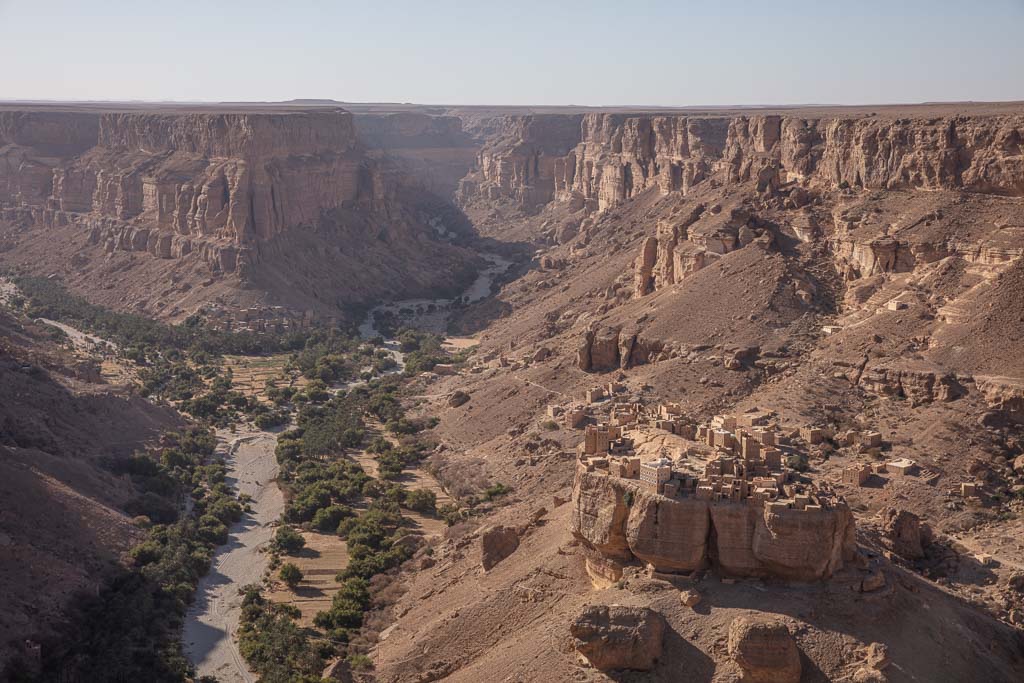
After watching one of the world’s best sunrises, we went in for breakfast before our long day began. On our agenda? A half-day hike down into the wadi. Did you think we could possibly visit here without taking on a trek?
We drove a little further southeast from our guesthouse to begin. With the help of a man from one of the villages below leading the way began our descent.

Though we had gotten an early start, part of me wished we had begun the trek even earlier. In the cold of February, Central Yemen is quite hot once the sun comes up.
We made our way down into a narrowing slot that would eventually twist and turn to meet Wadi Daw’an. The men, of course, were cruising along, but us three girls in the back were dragging our feet and complaining… but hear me out.
Have you ever tried to go on a hike in an abaya, a headscarf, and a niqab? Granted our niqabs weren’t drawn down (so at least we could breathe), they were still tightly tied onto our heads (I had a headache on several days of the trip from mine as I don’t wear a niqab full time), just in case we ran into someone else on the route and flip them back down.
I was struggling the least, but this wasn’t my first time either- I had worn my pack with a hip belt, knowing well that I could tuck in the midsection of my abaya into the belt and have my scandalous black legging covered legs showing from the knee down. My other two female counterparts had on looser, billowing (and in my opinion prettier) abayas- they aren’t very functional considering Yemen is mostly desert, so naturally, it’s littered with thorn-ridden devilish desert plants that cling onto your fluttering abaya at every opportunity.


We eventually arrived at a wadi pool (the one that I’m standing in the above photo) where we took a break before continuing on.

After we left the pool of water we meandered further down into the canyon to eventually arrive at a lower cliff’s edge with views directly across to Haid al Jazil, this time up close.


Before continuing on, Karen (aka Mama Khadija) sat admiring the view, snapped a few photos, and complained about our abaya-trekking difficulties. I could see myself growing frustrated if I was a Yemeni woman and just saying “Fuck it, fine, I’ll stay in the house and never leave if it means I don’t have to wear the equivalent of several black bed sheets that blow in the wind, obstruct your view and cause you to trip over everything.”
I know the abaya and niqab are deeply entrenched into the culture of Yemen, but what a prison-like garment- I felt even the chadri, Afghanistan’s famous blue burqa, was much more functional. When I had visited Yemen in the past, the country was still largely a dicey prospect for travel, but I didn’t wear a niqab back then as things were a bit less chaotic, and locals scoffed at the idea of a foreign woman wearing one.
Despite all the complaining we did about the abaya and niqab, I still think it’s a good reminder of the freedoms we do have in our home countries and gives a short, if fleeting notion of what women in Yemen go through. Many women in North America and Europe quite literally wig the fuck out at the sight of a burqa or a niqab (sometimes even just a headscarf), and I’ll agree, life isn’t easy for Yemeni women (or women in other countries with oppressive reputations), but the extremely conservative dress, whether worn by force or pressure, is the lesser of the countless oppressions women here face in life.
We reached the floor of Wadi Daw’an a short while later and have a packed lunch sat under some date palms right next to Haid al Jazil. The hike from near our guesthouse to the base of Haid al Jazil took about 3 hours, including breaks and moving rather sluggishly due to our outfits.


Learn everything you need to know about crossing the Yemen-Oman border
Hufah
After lunch, we continued back to the northwest, our first stop being in the village of Hufah. Hufah is more or less just a small scattering of Hadhrami mudbrick homes pushed up against a sandstone cliff on an incline sat behind a dusty field, but interesting nonetheless.

A few young boys giggled and laughed sitting at the corner of a building and started pointing toward themselves and motioning that they wanted their photos taken.



After a short visit to Hufah, we decided to hit the road back up toward the guesthouse to take a mid-afternoon break as we were nearing the hottest part of the day. A short way along the dusty road we saw a shepherdess out with her goats crossing a dry riverbed.

The Khayla Buqshan Palace
After a break from the midday heat, we headed back into the Wadi. We were mostly off to explore the other side of Wadi Daw’an, but first, we paid a visit to the Buqshan Palace in Khayla.


The Khayla Buqshan Palace was owned by a wealthy Hadhrami family that relocated to Saudi Arabia. Built in 1955, Buqshan Palace sat untouched for nearly 46 years until the owner returned and had the palace renovated in 2003-2004. In 2006 the first and second floors of Buqshan Palace were converted into a hotel and the third floor into the Khayla Development Committee Office, which works to promote investment into Khalya and the surrounding communities, and into the infrastructure.


The Buqshan Palace feels almost like a museum, getting a glimpse into what aristocratic life among wealthy Hadhrami families was like. The palace features colorful outer walls, and some of the rooms in the upstairs have colorful and intricate ceiling paintings. Buqshan still exhibits the traditional features of Hadhrami mudbrick architecture.


We spent some time climbing to the very top of Buqshan Palace and enjoying the surrounding views. The colorful paint is faded from the sun but still is a lively change-up from the tan and white mudbrick building surrounding it.
There is also a second palace in Khayla owned by the same family that is visible from the rooftop of Buqshan Palace.
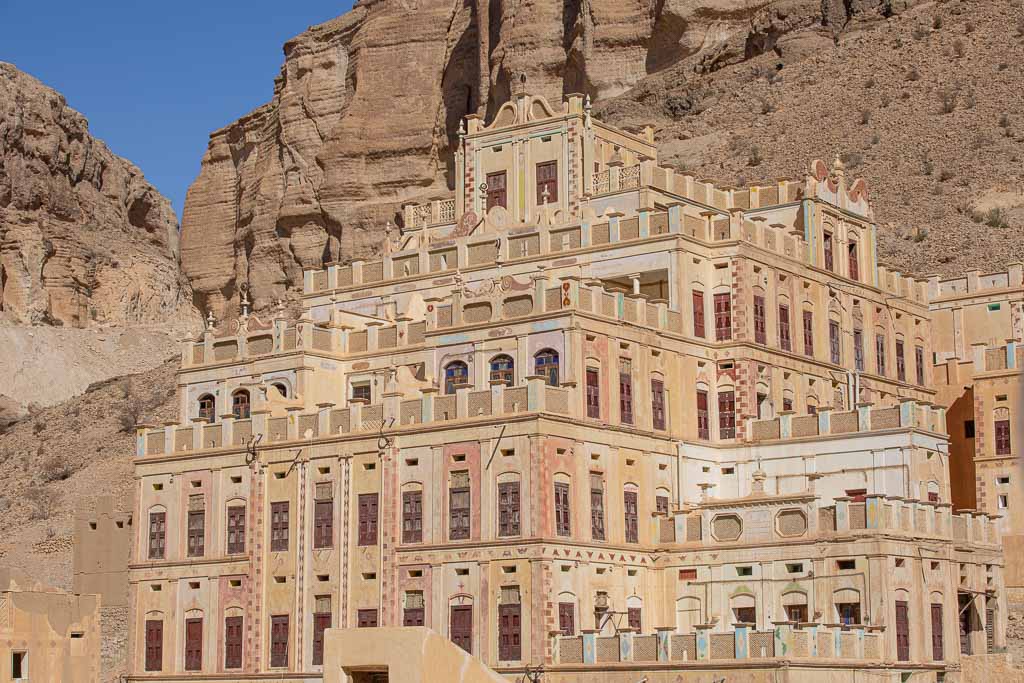
Thinking about the otherworldly island of Socotra? Check out my Socotra Travel Guide
The “Other” Side Of Wadi Daw’an: Wadi Daw’an Layman
After our visit to the Buqshan Palace, we set out to explore the other side of Wadi Daw’an. We bound back northwest of Haid al Jazil from the way we came the day prior.
If you look at a map and follow the path of the canyon from north to the south, Wadi Daw’an branches about midway. At the village of Tafilah, the wadi actually forks into two, with Wadi Daw’an Layasar, meaning ‘Wadi Daw’an Right’ continuing to the southeast toward Haid al Jazil, and the other side known as Wadi Daw’an Layman, meaning “Wadi Daw’an Left’ bounding to the south toward Ar Ribat.

Husn Fort, Qarn Majid
Our first stop along the straight southern route down Wadi Daw’an was in to Qarn Majid. Qarn Majid is a small village, home to the Husn Fort, a mudbrick palace built atop a massive precipice rising from the wadi floor, looming over Qarn Majid. The Husn Fort of Qarn Majid was originally constructed during the 19th century for Sheikh Abdullah bin Muhammad Quhum Al Amudi who was originally from the nearby village of Budah.

Husn Fort was badly damaged by flooding of the Wadi Daw’an area. In June 2013 the fort underwent extensive rehabilitation to repair and restore it save Husn from its impending demise. You can read more about the Daw’an Mud Brick Architecture Foundation’s project to restore Husn Fort here.
Learn more about Husn Fort & Qarn Majid

Al Jubayl
Inching further down into Wadi Daw’an’s other side, we stopped at the village of Al Jubayl and watched a fairly big football match. In the late afternoon between prayers it’s quite common to find boys out playing football all throughout Yemen.

Al Khuraiba
The furthest south we’d travel in Wadi Daw’an was to the village of Al Khuraiba. From our parked car along the dusty road, we walked out onto a platform that seemed to be an unfinished home or building of some sort.
From here we had grand views into the side wadi veering southwest off of this particular branch of Wadi Daw’an. Al Khuraiba spans both sides of the canyon, separated by lush, green date palms on the main north-west portion.
Across the date palms on the other side of the wadi the village wrapped around a corner and seemed to stretch on down it, on both sides of the offshoot wadi.

This was at the point we got a call from the general that oversees the area of Wadi Daw’an. We were told to not go further south beyond Al Khuraiba and turn around.
On a side note, when people demand to know why it costs so much to visit countries like Yemen (there seems to be this notion in the travel community that if much of the inhabitants of a country live in poverty, then it must be cheap to visit), it’s because of security. Not only are you paying for the expertise of a guide/fixer who is well connected and really knows what he’s doing, you’re also paying for the watchful eye of members of the community who will advise if trouble may be headed your way, or if there is a potential problem coming up. The general was on to our wishes to visit Ar Ribat, the next village, about two kilometers to the south.
Ar Ribat is the ancestral home of the Bin Laden family. Mohammed Bin Laden, like many Hadhramis, left his home to pursue wealth outside of Yemen.
In 1931 Mohammed Bin Laden left for Saudi Arabia where he would go on to establish one of the largest and most prosperous construction companies in the world, the Bin Laden group. Mohammed would go on to become the wealthiest non-royal Saudi in the kingdom until his death in 1967 in a plane crash. Mohammed Bin Laden would father 56 children to 22 wives throughout his life, the 17th of which would go on to found the terrorist organization of Al Qaeda.

Tamlah
From Al Khuraiba we turned back north, making occasional stops along the way to finally reach the village of Tamlah. Tamlah is a bustling market town on the northern end of Wadi Daw’an Layman that sprawls both sides of the road. The village of Tamlah serves as a crossroads for locals from the surrounding villages, where people come to do shopping, purchase produce, have cars, trucks, and motorbikes repaired, and catch shared taxis bound for other parts of Wadi Daw’an and beyond.
Tamlah is also a great place to purchase antique items as there are numerous shops selling various wares inside. If you get to talking to the shopkeepers and happen to be looking for something specific, don’t be surprised if they start phoning friends from nearby to have them bring down any potential items you may want to purchase that they’re looking to sell. Karen mentioned wanting to buy a jambiya, and within about 15 minutes we actually had two different jambiyas there, both of which were antique Bedouin-style jambiya, with sheaths quite unique from the one I own (Sana’ani) and the one at Kais’s hip.


As we stayed in Tamlah for a while, looking at different shops, we had attracted a crowd of onlookers, word travels fast in these parts as someone likely overheard our conversations about jambiya.

As the sun began to drop fast, we had to finally wrap up our shopping in Tamlah and make way back to our guesthouse. Despite Wadi Daw’an in general, being a reasonably safe location as far as Yemen is concerned, it’s still advisable not to travel after dark.



We made our way back to the wadi’s northeastern rim to sleep once more night before heading out of Wadi Daw’an the following day.

The next morning we caught yet another epic sunrise over Wadi Doan before having breakfast and departing for the village of Sif.
Read about the Sufi crossroads in Tarim, Yemen

Sif
Sif is just a bit north of where Wadi Daw’an divides and is one of the larger villages of the canyon. We had planned to visit the Palace of Sif, a white castle that looms over the city, but never made it.
First, we visited a boys’ school, spoke with one of the instructors, and briefly sat in on a class before the boys broke for lunch. The boys ended up escorting us from the boys’ school to the girls’ school where we ended up spending most of our time.



Three female instructors welcomed us in, chatting with us and taking us classroom to classroom to meet the girls. Finally, in one of the older classes of first aged 12-14, the instructors kicked Matt and Kais out. My other two female counterparts followed, I believe thinking that they had lessons to get to.

Then it happened- one of the teenage girls kicked the door shut, the rest of the girls had me pushed into a corner. Soon after wails of laughter erupted and niqabs flipped back.
The girls were too shy to really interact much with men in the room (as I would have expected) and their true colors came out. Many of the girls spoke a few phrases in English and eagerly practiced with me, while others would interject in Arabic and much to their amusement I knew a handful of words and phrases to which they all would giggle at my responses (I’m sure due to my thick accent). The girls would tell me about their dreams to visit both my countries of citizenship- the USA and Italy.
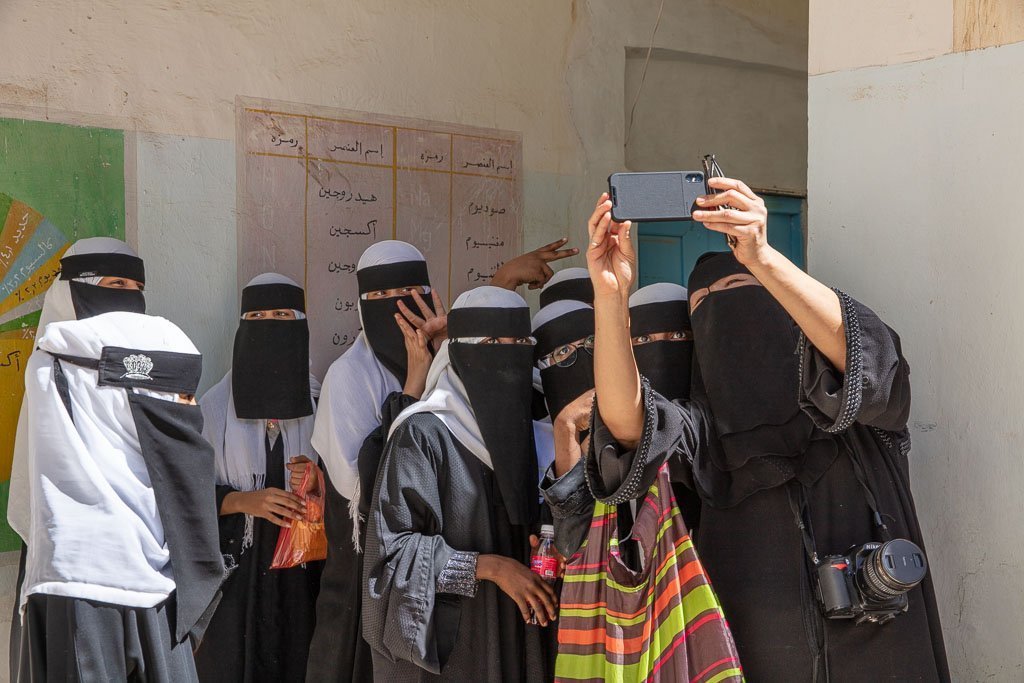
Before long my two travel buddies returned and jumped in on the action. The girls grabbed out mobile phones to snap photos with us and asked us to take pictures with them on ours.
A couple of pieces of parchment hit a desk and a flutter of paper whirled by as the girls demonstrated their knowledge of English by pointing to objects drawn on the large sheets of paper by yelling the name of the items between giggles.


Eventually, we did have to leave as the girls’ had lesson plans to get to and we needed to make our way toward Shibam. I think we all could have honestly stayed there at the school for weeks, it was definitely a highlight of our time in Wadi Daw’an. Before we left two of the teachers exchanged phone numbers with us. We’ve kept in touch ever since.
Liquid Gold: Sidr Honey
After we said our goodbyes to the girls and their teachers, we headed north, back to Al Hajarayn, one of our first stops in Wadi Daw’an. This time we were there to visit a honey shop on the outskirts of town.

The Hadhramaut region is famed for its prized honey, being of the highest quality, arguably in the world. Honey that originates from Hadhramaut comes with a high price tag as well in comparison to that bear-shaped squeeze tube you probably have in your cabinet. With all this said, the Sidr honey that comes from Wadi Daw’an, in particular, is widely known to be the cream of the crop when it comes to honey. The highest grade of Sidr honey sells for $85 USD per kilogram.


Naturally, all four of us plus Kais and Wagdi clambered up to the counter of the shop to take turns tasting the different types of honey and hearing about their origins and uses. I had already had people back home that sent me with a list of what they wanted to purchase and have me bring to them.

The nectar of the Ziziphus spina-christi tree’s flowers that are native to Wadi Daw’an are the secret to the valley’s famed honey. Referred to as the Sidr tree, are the source of the nectar that gives the Sidr honey its unique and aromatic flavor.
Sidr honey is also called Groom’s Honey, a name gained from the belief that the honey serves as a natural Viagra for the groom on his wedding night.
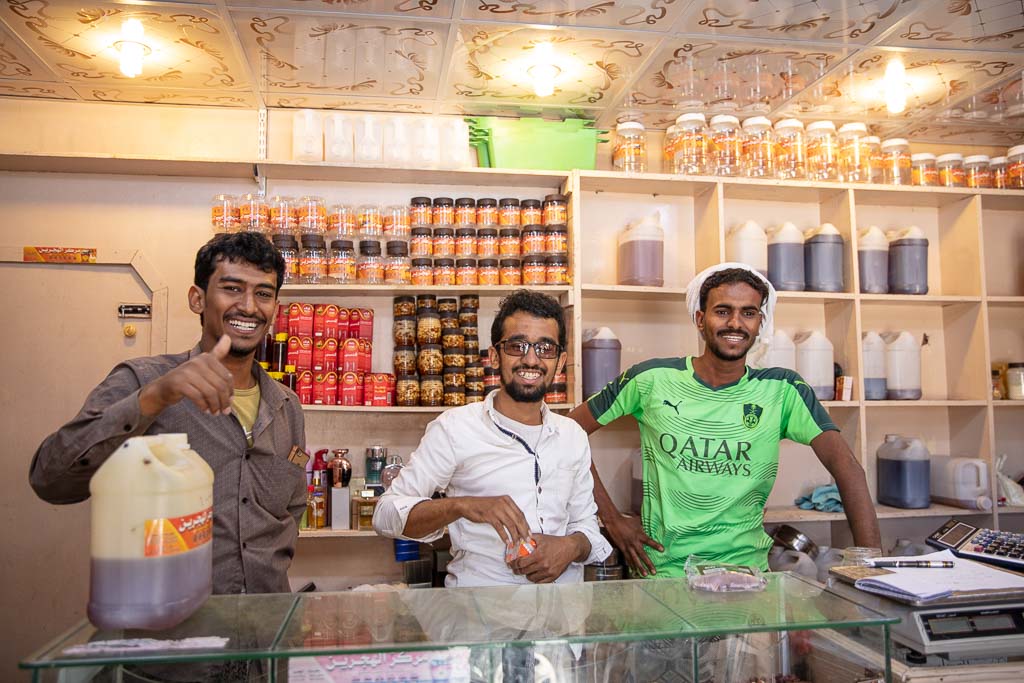
The men working at the honey shop all chuckled as Kais translated our questions regarding the Groom’s Honey to them and laughed as they responded and Kais told us their response.
Al Hajarayn was our final stop in Wadi Daw’an before we continued our journey through the Hadhramaut region to the legendary city of Shibam.
Right as we exited the wadi though, we ended up spotting a couple of shepherdesses out with their grazing goats.

Have Questions About Visiting Wadi Daw’an
I arranged this unique addition to a trip into Mainland Yemen and on to Socotra with my guys over at Inertia Network. If you want to set up your own, contact me at adventuresoflilnicki @ gmail.com or over at contact @ inertianetwork.com.
Need Travel Insurance for Yemen?
Start shopping plans over at battleface.






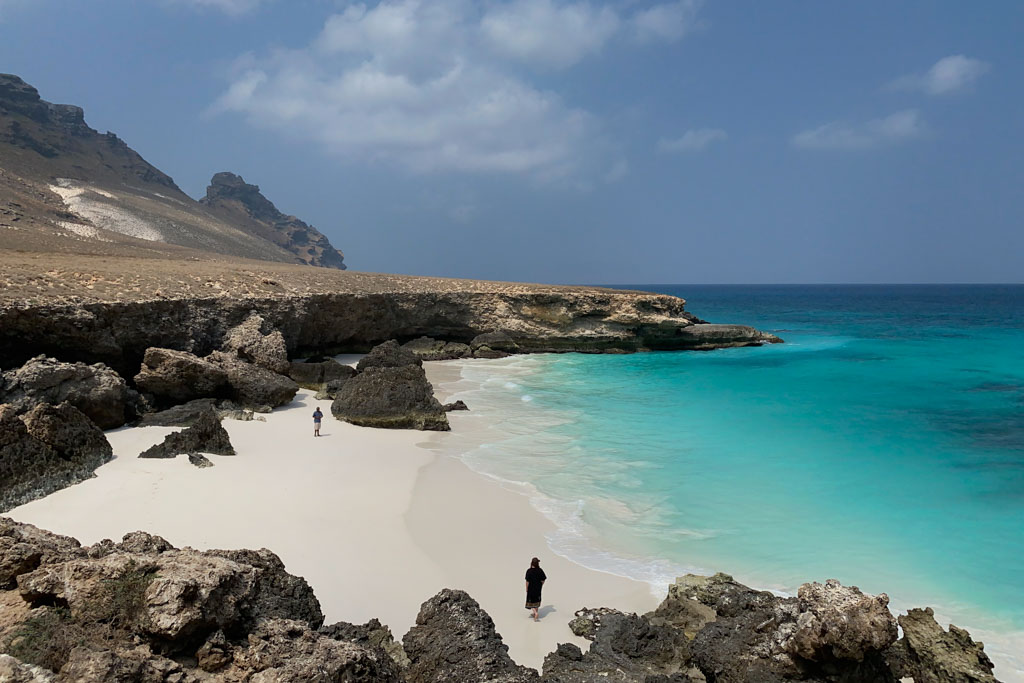









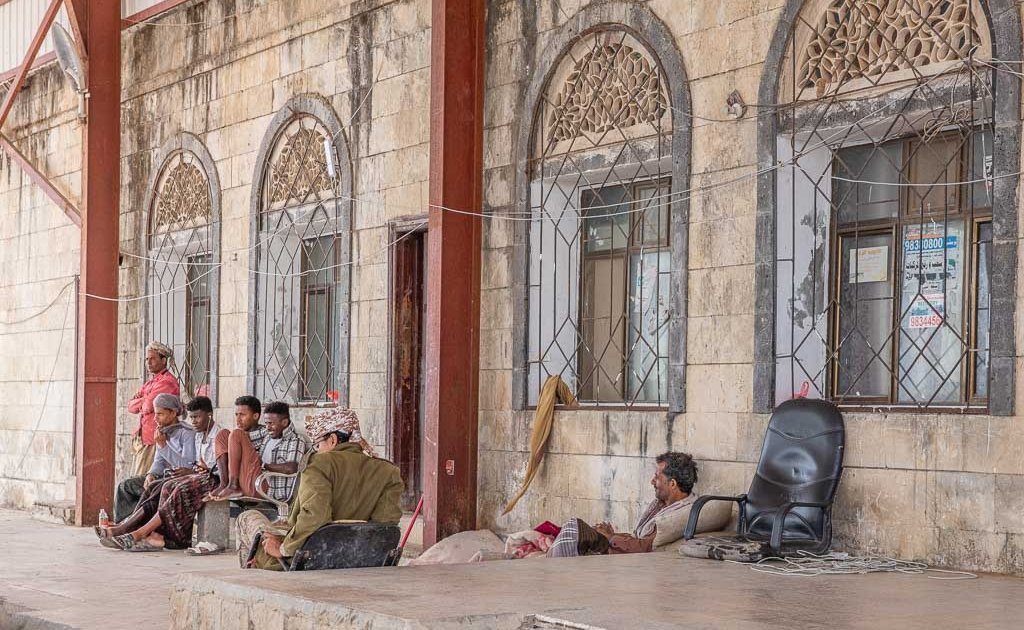










Thanks for your visit to my beautiful valley, I hope you had a great time.
I felt sad when you did not mention anything about my village “Budhah” but then I realized you gave it a wrong name “Tamlah” .
It is great to know how others look to your culture and tradition.
Oh good to know, I had saw it marked as Tamlah on the map
Great post! This made me laugh: “Did you think we could possibly visit here without taking on a trek?” I asked Kais if anyone hiked in the area and he said no. We didn’t have time anyway. I was disappointed at the time, but now reading your post I realized I would have hated hiking in a niqab and abaya.
I was envious of Ashlee’s beautiful flowey abaya and niqab she bought in Muscat until that hike! Although I’ll never forget how comical it was seeing both of their niqabs stuck in a thorny desert tree and having to stop to help free each other without destroying our outfits. Lovely hike, but what a pain in the ass trying to move around in those abayas.